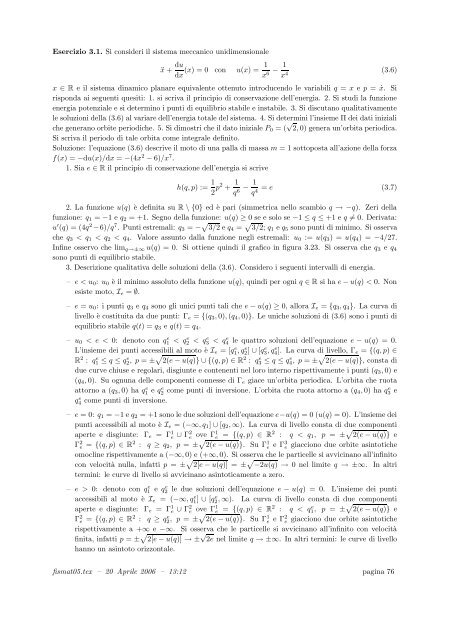Esercizi e appunti per il corso di Fisica Matematica - Sezione di ...
Esercizi e appunti per il corso di Fisica Matematica - Sezione di ...
Esercizi e appunti per il corso di Fisica Matematica - Sezione di ...
You also want an ePaper? Increase the reach of your titles
YUMPU automatically turns print PDFs into web optimized ePapers that Google loves.
<strong>Esercizi</strong>o 3.1. Si consideri <strong>il</strong> sistema meccanico uni<strong>di</strong>mensionaleẍ + dudx (x) = 0 con u(x) = 1 x 6 − 1 x 4 (3.6)x ∈ R e <strong>il</strong> sistema <strong>di</strong>namico planare equivalente ottenuto introducendo le variab<strong>il</strong>i q = x e p = ẋ. Sirisponda ai seguenti quesiti: 1. si scriva <strong>il</strong> principio <strong>di</strong> conservazione dell’energia. 2. Si stu<strong>di</strong> la funzioneenergia potenziale e si determino i punti <strong>di</strong> equ<strong>il</strong>ibrio stab<strong>il</strong>e e instab<strong>il</strong>e. 3. Si <strong>di</strong>scutano qualitativamentele soluzioni della (3.6) al variare dell’energia totale del sistema. 4. Si determini l’insieme Π dei dati inizialiche generano orbite <strong>per</strong>io<strong>di</strong>che. 5. Si <strong>di</strong>mostri che <strong>il</strong> dato iniziale P 0 = ( √ 2, 0) genera un’orbita <strong>per</strong>io<strong>di</strong>ca.Si scriva <strong>il</strong> <strong>per</strong>iodo <strong>di</strong> tale orbita come integrale definito.Soluzione: l’equazione (3.6) descrive <strong>il</strong> moto <strong>di</strong> una palla <strong>di</strong> massa m = 1 sottoposta all’azione della forzaf(x) = −du(x)/dx = −(4x 2 − 6)/x 7 .1. Sia e ∈ R <strong>il</strong> principio <strong>di</strong> conservazione dell’energia si scriveh(q, p) := 1 2 p2 + 1 q 6 − 1 q 4 = e (3.7)2. La funzione u(q) è definita su R \ {0} ed è pari (simmetrica nello scambio q → −q). Zeri dellafunzione: q 1 = −1 e q 2 = +1. Segno della funzione: u(q) ≥ 0 se e solo se −1 ≤ q ≤ +1 e q ≠ 0. Derivata:u ′ (q) = (4q 2 −6)/q 7 . Punti estremali: q 3 = − √ 3/2 e q 4 = √ 3/2; q 1 e q 5 sono punti <strong>di</strong> minimo. Si osservache q 3 < q 1 < q 2 < q 4 . Valore assunto dalla funzione negli estremali: u 0 := u(q 3 ) = u(q 4 ) = −4/27.Infine osservo che lim q→±∞ u(q) = 0. Si ottiene quin<strong>di</strong> <strong>il</strong> grafico in figura 3.23. Si osserva che q 3 e q 4sono punti <strong>di</strong> equ<strong>il</strong>ibrio stab<strong>il</strong>e.3. Descrizione qualitativa delle soluzioni della (3.6). Considero i seguenti intervalli <strong>di</strong> energia.– e < u 0 : u 0 è <strong>il</strong> minimo assoluto della funzione u(q), quin<strong>di</strong> <strong>per</strong> ogni q ∈ R si ha e − u(q) < 0. Nonesiste moto, I e = ∅.– e = u 0 : i punti q 3 e q 4 sono gli unici punti tali che e − u(q) ≥ 0, allora I e = {q 3 , q 4 }. La curva d<strong>il</strong>ivello è costituita da due punti: Γ e = {(q 3 , 0), (q 4 , 0)}. Le uniche soluzioni <strong>di</strong> (3.6) sono i punti <strong>di</strong>equ<strong>il</strong>ibrio stab<strong>il</strong>e q(t) = q 3 e q(t) = q 4 .– u 0 < e < 0: denoto con q1 e < q2 e < q3 e < q4 e le quattro soluzioni dell’equazione e − u(q) = 0.L’insieme dei punti accessib<strong>il</strong>i al moto è I e = [q1 e, qe 2 ] ∪ [qe 3 , qe 4 ]. La curva <strong>di</strong> livello, Γ e = {(q, p) ∈R 2 : q1 e ≤ q ≤ q2, e p = ± √ 2(e − u(q)} ∪ {(q, p) ∈ R 2 : q3 e ≤ q ≤ q4, e p = ± √ 2(e − u(q)}, consta <strong>di</strong>due curve chiuse e regolari, <strong>di</strong>sgiunte e contenenti nel loro interno rispettivamente i punti (q 3 , 0) e(q 4 , 0). Su ognuna delle componenti connesse <strong>di</strong> Γ e giace un’orbita <strong>per</strong>io<strong>di</strong>ca. L’orbita che ruotaattorno a (q 3 , 0) ha q1 e e qe 2 come punti <strong>di</strong> inversione. L’orbita che ruota attorno a (q 4, 0) ha q3 e eq4 e come punti <strong>di</strong> inversione.– e = 0: q 1 = −1 e q 2 = +1 sono le due soluzioni dell’equazione e−u(q) = 0 (u(q) = 0). L’insieme deipunti accessib<strong>il</strong>i al moto è I e = (−∞, q 1 ] ∪ [q 2 , ∞). La curva <strong>di</strong> livello consta <strong>di</strong> due componentia<strong>per</strong>te e <strong>di</strong>sgiunte: Γ e = Γ 1 e ∪ Γ2 e ove Γ1 e = {(q, p) ∈ R2 : q < q 1 , p = ± √ 2(e − u(q)} eΓ 2 e = {(q, p) ∈ R 2 : q ≥ q 2 , p = ± √ 2(e − u(q)}. Su Γ 1 e e Γ 3 e giacciono due orbite asintoticheomocline rispettivamente a (−∞, 0) e (+∞, 0). Si osserva che le particelle si avvicinano all’infinitocon velocità nulla, infatti p = ± √ 2[e − u(q)] = ± √ −2u(q) → 0 nel limite q → ±∞. In altritermini: le curve <strong>di</strong> livello si avvicinano asintoticamente a zero.– e > 0: denoto con q1 e e q2 e le due soluzioni dell’equazione e − u(q) = 0. L’insieme dei puntiaccessib<strong>il</strong>i al moto è I e = (−∞, q1 e] ∪ [qe 2 , ∞). La curva <strong>di</strong> livello consta <strong>di</strong> due componentia<strong>per</strong>te e <strong>di</strong>sgiunte: Γ e = Γ 1 e ∪ Γ 2 e ove Γ 1 e = {(q, p) ∈ R 2 : q < q1, e p = ± √ 2(e − u(q)} eΓ 2 e = {(q, p) ∈ R2 : q ≥ q2 e, p = ±√ 2(e − u(q)}. Su Γ 1 e e Γ2 e giacciono due orbite asintoticherispettivamente a +∞ e −∞. Si osserva che le particelle si avvicinano all’infinito con velocitàfinita, infatti p = ± √ 2[e − u(q)] → ± √ 2e nel limite q → ±∞. In altri termini: le curve <strong>di</strong> livellohanno un asintoto orizzontale.fismat05.tex – 20 Apr<strong>il</strong>e 2006 – 13:12 pagina 76
















